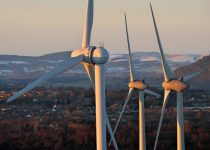How farmers could lead the green energy revolution | Agrivoltaics | All Science. No Fiction.
[light music] NARRATOR: More energy from
the sun hits the Earth every hour than humans use in a year. But if we wanna up the use
of that carbon-free power, we'll have to capture a lot more of it. That will take space, heaps of it. And finding space for solar arrays that doesn't sacrifice the environment or other things people care about… Well that? Is All Science. No Fiction. [bouncy music] [plate meter beeping] Every few weeks, Oregon State
grad student, Alyssa Andrew, takes a stroll through the solar array. ALYSSA: This is a plate meter. So we basically just go… NARRATOR: It gives her
the height of the grass. You want about 30 measurements per plot.
NARRATOR: The ground cover is a mix of grasses, clover, and other plants that provide a delicious lunch for the solar array's current residents. [sheep bleating] ALYSSA: Usually one of them will come up, and either the other ones will
follow or they'll just stare, like, "I kinda want pets, but also I don't know if I trust you." NARRATOR: Andrew is studying
pasture growth, water use, how quickly the lambs are growing, and if the panels cause them stress.
ALYSSA: Just from personal experience, they seem to like it better. [chuckles] NARRATOR: And some of
her results comparing this kind of pasture to
open fields are surprising. Around the panels, the
lambs chunked up fast, almost as fast as in the open. ALYSSA: Plants underneath the panels tend to have higher leaf area, so that way they can
capture more sunlight. So it had better
nutritional values for them. NARRATOR: The research is
showing the untapped potential of what's been dubbed agrivoltaics. I spend a lot of my time thinking about what I can do
that's transformational, that's not just a little better, something that's gonna
change the way we think. NARRATOR: It's thinking that
will eventually help make the most out of solar projects, like this one already
underway in Southern Oregon. CHAD: We're working on something that I think can have a huge impact.
NARRATOR: Agrivoltaics pairs agriculture and solar power production to
the mutual benefit of both. Think salt and caramel, gin and tonic, ranch and, well, anything. They're better together. Solar likes to be in places
that have flat ground, plenty of sun, already
ecologically disturbed, deep soils, close to an urban area so that we have access to
markets and infrastructure. I just described agricultural land. NARRATOR: Drive through a rural area and you've probably seen it: farm fields that have been decommissioned and converted to solar installations. It's usually one or the other. But Higgins' research is showing ways of doing both together. I think the keyword are
more food, better food, less water, extra revenue for the farm. It's a four-way win for farmers.
NARRATOR: And it's a huge
win for everyone else if it helps us stop burning fossil fuels. The solution to climate
change is rural America. NARRATOR: So how does all this agrivoltaic benefit happen? [light music]
[air whooshes] Well, solar panels can extend
growing seasons for some crops by protecting them from
frost in the winter and from the intense sun of summer. CHAD: So you can push the
seasons out in both directions when it's designed right.
NARRATOR: And while farmers would lose some plantable ground to the panels, they could make up for
it by selling the energy. CHAD: A guaranteed revenue stream that you can count on every year. NARRATOR: But of all the benefits that agrivoltaic systems could provide, the impact on water use
may be the most intriguing. MATT DAVIS: If we were a
big commercial operation, we wouldn't be doing it this way, but research is a little less efficient. Water is an issue. Our climate is getting hotter and dryer, and if we wanna continue
to grow food and eat, then we we need to look at alternatives. NARRATOR: Garrett studies dry farming. That's growing crops without irrigation. AMY: Hm, so this is Adirondack Blue. I don't know actually know
what color it is on the inside. This is the first time we've grown it. NARRATOR: Their harvest will show if dry farming different
varieties of potatoes in the shelter of solar panels
gives them any added boost. Potatoes are more shade-tolerant
than some other crops that love full sun like
tomatoes and squash and melons and dry beans and corn.
NARRATOR: Agrivoltaics pairs
nicely with dry farming because the panels can reduce how much precious water is lost to evaporation and transpiration,
you know, plant sweat. AMY: In the solar setting,
there's definitely, not just a shading effect, but a sheltering effect
from the wind as well. NARRATOR: And Garrett is
finding some potato varieties are doing better around the
panels than in full sun. But despite the promising results, agrivoltaics are not gonna work for every crop and every climate, and big outstanding
questions about grid access and upfront costs linger. We don't have to make it
work everywhere, right? We can pick and choose
and pick the best spots. It's our universe to design.
NARRATOR: It's a universe
built on science and technology that puts rural communities at its center. 10 years from now, 20 years
from now, we'll have that. We'll have the designs. It won't be a research question anymore. It'll be a reality. NARRATOR: And in agrivoltaics,
Higgins sees a future that's bright enough to
power the entire country. [sheep bleating] [ranch sloshing] Fingers crossed. [wind whooshing] Woo-hoo! [beans clatter] It takes a lot of beans to
make "All Science. No Fiction" and OPB's other great shows and series. Show your support for OPB
by making a gift today. Thanks!.


